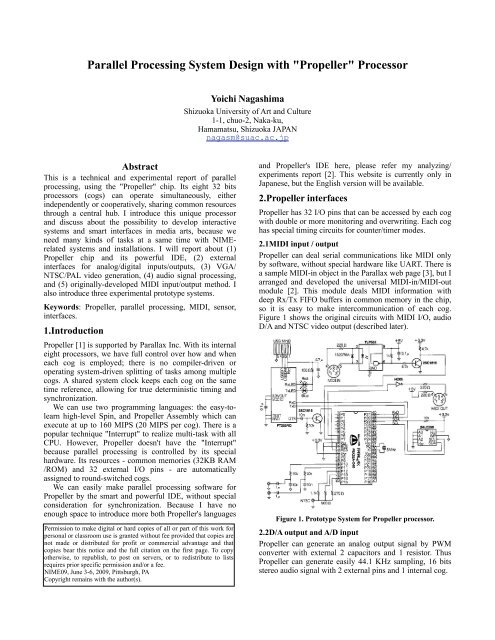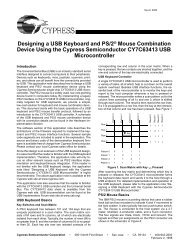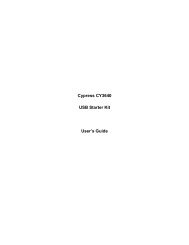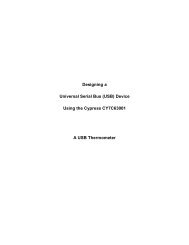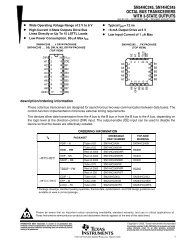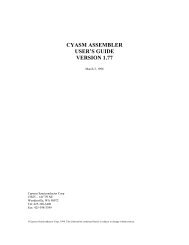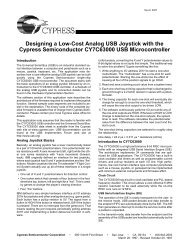Parallel Processing System Design with "Propeller" Processor
Parallel Processing System Design with "Propeller" Processor
Parallel Processing System Design with "Propeller" Processor
Create successful ePaper yourself
Turn your PDF publications into a flip-book with our unique Google optimized e-Paper software.
<strong>Parallel</strong> <strong>Processing</strong> <strong>System</strong> <strong>Design</strong> <strong>with</strong> "Propeller" <strong>Processor</strong>Yoichi NagashimaShizuoka University of Art and Culture1-1, chuo-2, Naka-ku,Hamamatsu, Shizuoka JAPANnagasm@suac.ac.jpAbstractThis is a technical and experimental report of parallelprocessing, using the "Propeller" chip. Its eight 32 bitsprocessors (cogs) can operate simultaneously, eitherindependently or cooperatively, sharing common resourcesthrough a central hub. I introduce this unique processorand discuss about the possibility to develop interactivesystems and smart interfaces in media arts, because weneed many kinds of tasks at a same time <strong>with</strong> NIMErelatedsystems and installations. I will report about (1)Propeller chip and its powerful IDE, (2) externalinterfaces for analog/digital inputs/outputs, (3) VGA/NTSC/PAL video generation, (4) audio signal processing,and (5) originally-developed MIDI input/output method. Ialso introduce three experimental prototype systems.Keywords: Propeller, parallel processing, MIDI, sensor,interfaces.1.IntroductionPropeller [1] is supported by Parallax Inc. With its internaleight processors, we have full control over how and wheneach cog is employed; there is no compiler-driven oroperating system-driven splitting of tasks among multiplecogs. A shared system clock keeps each cog on the sametime reference, allowing for true deterministic timing andsynchronization.We can use two programming languages: the easy-tolearnhigh-level Spin, and Propeller Assembly which canexecute at up to 160 MIPS (20 MIPS per cog). There is apopular technique "Interrupt" to realize multi-task <strong>with</strong> allCPU. However, Propeller doesn't have the "Interrupt"because parallel processing is controlled by its specialhardware. Its resources - common memories (32KB RAM/ROM) and 32 external I/O pins - are automaticallyassigned to round-switched cogs.We can easily make parallel processing software forPropeller by the smart and powerful IDE, <strong>with</strong>out specialconsideration for synchronization. Because I have noenough space to introduce more both Propeller's languagesPermission to make digital or hard copies of all or part of this work forpersonal or classroom use is granted <strong>with</strong>out fee provided that copies arenot made or distributed for profit or commercial advantage and thatcopies bear this notice and the full citation on the first page. To copyotherwise, to republish, to post on servers, or to redistribute to listsrequires prior specific permission and/or a fee.NIME09, June 3-6, 2009, Pittsburgh, PACopyright remains <strong>with</strong> the author(s).and Propeller's IDE here, please refer my analyzing/experiments report [2]. This website is currently only inJapanese, but the English version will be available.2.Propeller interfacesPropeller has 32 I/O pins that can be accessed by each cog<strong>with</strong> double or more monitoring and overwriting. Each coghas special timing circuits for counter/timer modes.2.1MIDI input / outputPropeller can deal serial communications like MIDI onlyby software, <strong>with</strong>out special hardware like UART. There isa sample MIDI-in object in the Parallax web page [3], but Iarranged and developed the universal MIDI-in/MIDI-outmodule [2]. This module deals MIDI information <strong>with</strong>deep Rx/Tx FIFO buffers in common memory in the chip,so it is easy to make intercommunication of each cog.Figure 1 shows the original circuits <strong>with</strong> MIDI I/O, audioD/A and NTSC video output (described later).Figure 1. Prototype <strong>System</strong> for Propeller processor.2.2D/A output and A/D inputPropeller can generate an analog output signal by PWMconverter <strong>with</strong> external 2 capacitors and 1 resistor. ThusPropeller can generate easily 44.1 KHz sampling, 16 bitsstereo audio signal <strong>with</strong> 2 external pins and 1 internal cog.
We can also get A/D input <strong>with</strong> reference D/A output by1 internal cog and 2 pins, using Parallax's sample program.The Propeller's cog is fast enough for CD quality samplingconversion. I discovered and confirmed that the assemblylanguage of Propeller was specially designed to achieveaudio signal processing compactly and efficiently.2.3Analog (RC) inputBecause each cog of Propeller has an individual timingcircuit in it, RC-type (time constant circuit) A/Dconversion is simpler to construct. We can easily achievehigh accuracy and high speed A/D by the specification ofPropeller (80MHz, 32 bits). We can use many types ofsensors: CdS, strain-gauge, piezo, static-electricity, carbonrubber,electric-capacitor, etc.2.4NTSC/PAL/VGA video outputSurprisingly, Propeller can generate the video signal ofNTSC/PAL/VGA in the background, <strong>with</strong> 1 cog forgraphic driver and 1 cog for video signal D/A <strong>with</strong> only 3external resistors. So, we can produce many multimediasystems <strong>with</strong> using only 2 cogs of Propeller, and we canuse remaining cogs for 6 individual parallel tasks.3.Experimental ApplicationsAfter this research, I produced three experimental systems,and the third one is a media-installation work.3.1Double NTSC outputUsing 4 cogs for double NTSC video outputs, I developeda multi monitor MIDI-CG system. However, by thelimitation of Propeller's internal memory, the double CGdrawing-mode were only "storage-display like" <strong>with</strong>outdouble-buffer computing.3.2Propeller Compact Display ModuleNext, I produced a compact display module for CGgenerator and MIDI monitor. The small module issupported by Little PCB Solutions [4], and I developed theprototype Compact Display Module. The system generates3 patterns of realtime CG and MIDI display byHexadecimal format (see Figure 2).Figure 2. Prototype Compact Display Module.3.3"Dodeca Propeller"The newest work <strong>with</strong> Propeller is the installation workcalled "Dodeca Propeller". This was presented at MediaArt Festival 2008 at SUAC in Japan in December 2008.Figure 3 shows the system board and there are 13Propeller chips on it. We have two huge display systemsthat arrange 12 large-scale video monitors in SUAC."Dodeca Propeller" was designed for this display system,so the output is 12 NTSC video lines.12 display Propeller run the real-time CG generatingprogram. The "controller" Propeller works as: MIDIcontrol (foot switch sensors) receiver, individual real-timeOn/Off switcher for each 12 screen, and the sound sensorin the gallery hall to control display patterns. As animportant point, PC doesn't exist in the system thatachieves this complex real-time generation of 12 screensCG and the interaction <strong>with</strong> the sensors. I developed thissystem <strong>with</strong> 2 undergraduate students. It was very easy tomake CG programs of Propeller for the students, and Ithink that Propeller is a very good platform for educationof students' programming.Figure 3. <strong>System</strong> Board of "Dodeca Propeller".4.ConclusionsThis is my first report of the "Propeller" chip. I think (1) ithas deep possibility to design interactive systems, and (2)it is good for education in computer programming. I willreport next step in the future <strong>with</strong> some projects in mediaarts.References[1] Propeller General Information, Parallax Inc., http://www.parallax.com/tabid/407/Default.aspx[2] Yoichi Nagashima, Propeller Diary, http://nagasm.suac.net/ASL/Propeller/index.html[3] Tom Dimock, Propeller MIDI in objects, http://obex.parallax.com/objects/229/[4] µOLED-96-PROP, Little PCB Solutions, https://www.littlepcbsolutions.com/uOLED-96-PROP.html


